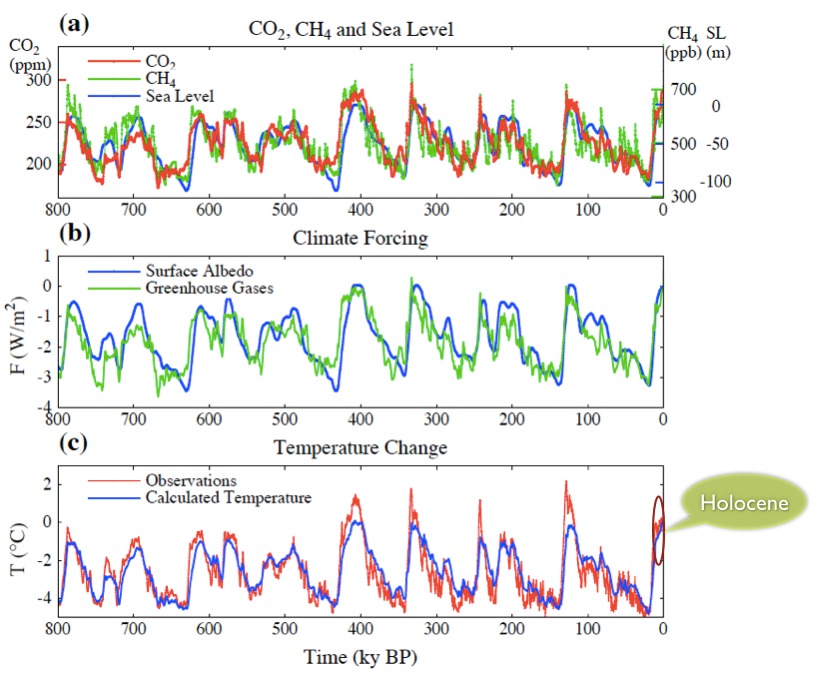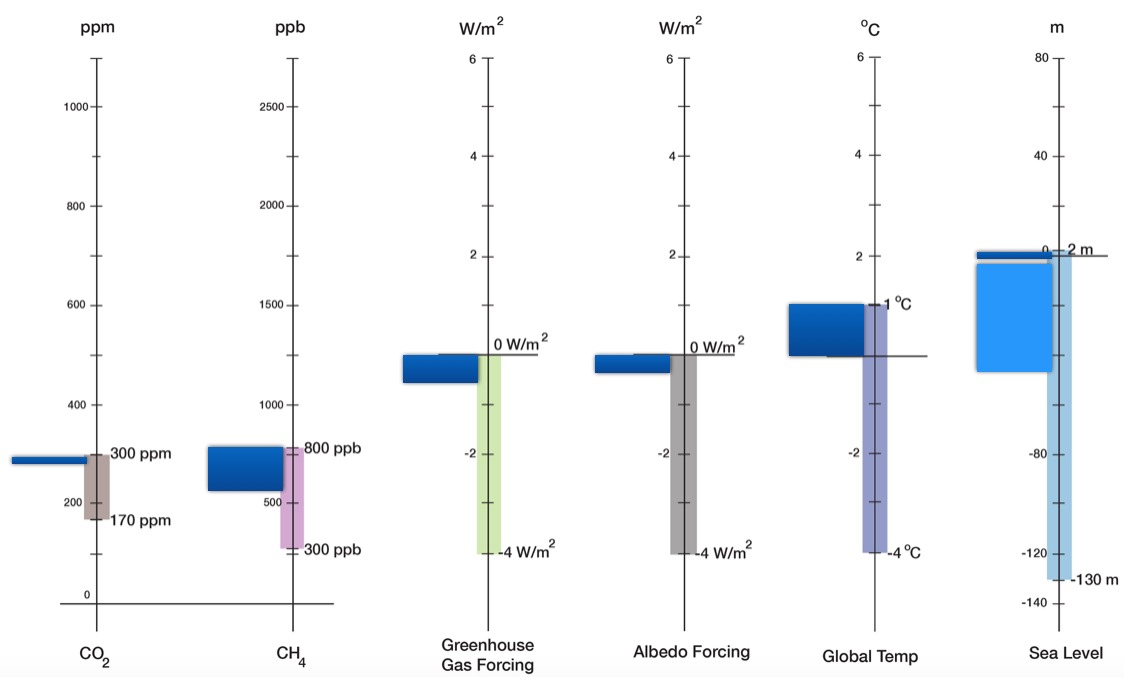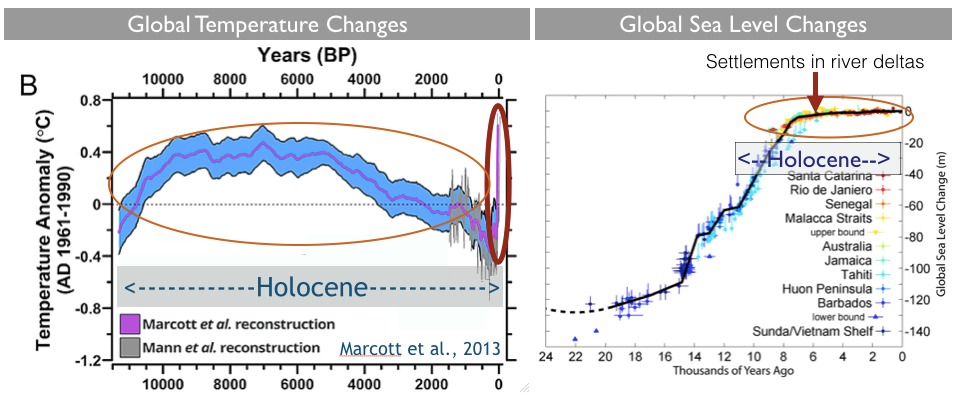Lab Sheet for Patient Earth
|
Planetary Base LineIn order to understand the extent of the syndrome of modern global change, it is important to establish a base line of the planetray system before humanity started to modify the planetary physiology fundamentally. This base line can be extracted from paleo data scientists have collected for the last one million years. Of particular interest is the base line for the Holocene, the last geological epoch that started roughly 11,700 years ago. The Holocene was a very stable period in Earth's history and this stability allowed humanity to develop civilization as we know it. 
Figure 1: Paleo data for climate-related variables for the last 800,000 years. The Holocene, the last geological epoch, was exceptionally stable. From Hansen et al. (2008). Figure 1 shows data for a number of climate-related variables for the last 800,000 years. During this period, climate was characterized by an alternating sequence of ice ages and interglacial warm periods. There is a strong correlation between changes in mean global air temperature, climate forcing variables such as albedo and greenhouse gasses, and sea level. The total range of global mean temperature throughout this long period was only on the order of 5oC. The corresponding range of atmospheric carbon dioxide (CO2) was on the order of 130 ppm, while sea level changed as much as 130 m. Thus, the long-term correlation between atmospheric CO2 is that 130 ppm correspond to 130 m in sea level and to 5oC in mean global air temperature. Utilizing the data in Figure 1, we can construct a base line as shown in Figure 2. The base line for the last 800,000 years shows relativley small ranges of variations in the most important climate variables. The total range of the mean global atmospheric temperature is less than 5oC, and the range of atmospheric CO2 is only 130 ppm. Methan (CH4) has a total range of 500 ppb and the combined Greenhouse gas climate forcing is limited to range of 4 W/m2.The variablility of climate forcing due to the albedo of the earth surface also is in a range of 4 W/m2. Changes in global mean sea level caused by the climate variability exhibt a range of 130 m, which introduced very large variations in the location of the coastal zones along the land-ocean boundary. Constraining the time interval to the Holocene, the total ranges for each variable are dramatically reduced. Here we consider the Holocene as the epoch that started approximately 11,700 years ago and ended with the full impact of the industrialization becoming clearly visible in Earth system variables. The dark blue boxes in Figure 2 show the ranges for each variable during the Holocene up to approximately 1880. Variations in the global mean temperature were limited to only 1oC with changes on century time scales being restricted to only one or two tenth of 1oC/century (Figure 3). The range of atmospheric CO2 is only roughly 15 ppm, and only methan shows a relatively larger range. 
Figure 2: Base Line for the normal ranges of climate-related variables during the last 800,000 years and during the Holocene (dark blue boxes). Read more about normal ranges ... The stability of the climate in the Holocene is exceptional, and this stability was extremely favorable for humanity. In fact, it created a safe operating space for humanity (Rockstrom et al., 2009). The stable climate supported humanity's transition to agriculture. When sea level becames stable, humans could for the first time develop permanent settlements in large river deltas and benefit from the logistic advanatges and the rich ecosystem services these areas offered. When global sea level was changing at rate of meters per century, it was not possible to settle in these beneficial areas because of the flat topography, coast lines where moving horizontally often 50 to 100 km in a century. 
Figure 3: Variation in global mean temperature and global mean sea level during the Holocene. The temperature was exceptionally stable (left). During the first third of the Holocene, sea level kept rising because the land-based ice masses were not in equilibrium with the global temperature, and sea level also became exceptionally stable once an equilibrium was reached. The Holocene can be characterized by planetary boundaries for essential variables. Rockström et al. (2009) identified boundaries for nine variables, including biogeochemical flows (in particular nitrogen and phosphorous cycles), global freshwater, change in land use, biodiversity loss (extinction rate), atmospheric aerosol loading, chemical pollution (and new constituents), climate change, ocean acidification, and stratospheric ozone depletion. They found that several of these boundaries have been crossed recently due to human activities, and this is pushing the Earth's life-support system out of the safe operating space. The stability of the Holocene climate ended when humanity created the syndrome of modern global change. Read more ... Read about climate basics ... ReferencesHansen, J., Sato, M., Kharecha, P., Beerling, D., Masson-Delmotte, V., Pagani, M., Raymo, M., Royer, D.~L., \& Zachos, J.~C., 2008. Target atmospheric CO2: Where should humanity aim? The Open Atmospheric Science Journal, 2, 217-231, Supplement. Rockström, J., Steffen, W., Noone, K., Persson, Å., Chapin, F. S.~I., Lambin, E., Lenton, T.~M., Scheffer, M., Folke, C., Schellnhuber, H., Nykvist, B., De~Wit, C.~A., Hughes, T., van~der Leeuw, S., Rodhe, H., Sörlin, S., Snyder, P.~K., Costanza, R., Svedin, U., Falkenmark, M., Karlberg, L., Corell, R.~W., Fabry, V.~J., Hansen, J., Walker, B., Liverman, D., Richardson, K., Crutzen, P., \& Foley, J., 2009. A safe operating space for humanity, Nature, 461, 472-475. Your Comments and QuestionsPlease, send us comments and input you might have on the baseline for Earth viability. Let us know if you have any questions. |
